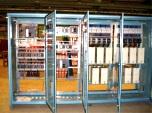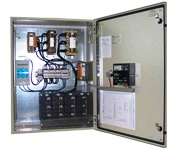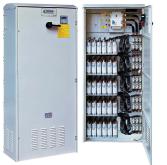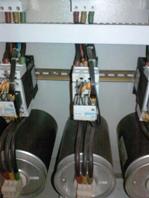Reactive power compensation devices
 Economics, statistics and performance reactive power compensation.
Economics, statistics and performance reactive power compensation.
According to local experts, the share of electricity is 30-40% in the cost of production. Therefore, saving energy is a very important factor in saving resources and achieving a competitive advantage.
One of the areas of energy saving is reducing the reactive power (increasing cosφ) since reactive power leads to an increase in electricity losses. In the absence of reactive power compensation devices, losses can vary from 10 to 50% of the average consumption.
Sources of loss
Note that at low values of cosφ (0.3-0.5), three-phase meters give an error in readings of up to 15%. The user will pay more due to incorrect meter readings, increased energy consumption, fines for low cosφ.
Reactive power leads to reduced power quality, phase imbalances, high frequency harmonics, heat losses, generator overload, frequency and amplitude spikes. Power quality standards are determined by GOST 13109-97.
Some statistics
 These disadvantages, ie. poor quality of electricity, lead to large economic losses. For example, in America in the late 1990s, studies were conducted that estimated the damage from poor power quality at 150 billion dollars per year.
These disadvantages, ie. poor quality of electricity, lead to large economic losses. For example, in America in the late 1990s, studies were conducted that estimated the damage from poor power quality at 150 billion dollars per year.
We have our own statistics in our country. The operation of microprocessor technology, medical equipment, telecommunication systems is often interrupted by short (a few milliseconds) drops or overloads of the supply voltage, which occur 20-40 times a year, but lead to expensive economic damage.
In this case, direct or indirect damages reach several million dollars per year. According to statistics, the complete loss of voltage is only 10% of the total number of faults, shutdowns lasting more than 1-3 seconds occur 2-3 times less often than shutdowns lasting less than 1 second. Dealing with short-term power outages is much more complicated and expensive.
Practical experience in measurement
Consider the contribution of various devices to increase reactive power. Asynchronous motors — it is about 40%; electric ovens 8%; converters 10%; various transformers 35%; power lines 7%. But these are only averages. The point is that cosφ equipment is highly dependent on its load. For example, if cosφ asynchronous electric motor at full load 0.7-0.8, then at low load it is only 0.2-0.4. A similar phenomenon occurs with transformers.
Methods and devices for reactive power compensation
 Since the specified reactive loads have a more inductive nature, then they are used for their compensation condensing units… If the load is capacitive in nature, inductors (chokes and reactors) are used to compensate.
Since the specified reactive loads have a more inductive nature, then they are used for their compensation condensing units… If the load is capacitive in nature, inductors (chokes and reactors) are used to compensate.
In more complex cases, automated filtering compensating units... They allow you to get rid of high-frequency harmonic components of the network, increasing the noise immunity of the equipment.
Regulated and unregulated installations for reactive power compensation
 Reactive power compensation installations are divided according to the degree of control, they are divided into adjustable and non-adjustable. Non-regulated are simpler and cheaper, but given the change in cosφ according to the degree of load, they can cause overcompensation, i.e. they are not optimal in terms of the maximum increase in cosφ.
Reactive power compensation installations are divided according to the degree of control, they are divided into adjustable and non-adjustable. Non-regulated are simpler and cheaper, but given the change in cosφ according to the degree of load, they can cause overcompensation, i.e. they are not optimal in terms of the maximum increase in cosφ.
Adjustable installations are good because they follow changes in the electrical network in a dynamic mode. With their help, you can increase cosφ to values 0.97-0.98. It also has monitoring, recording and indication of current readings. This allows further use of this data for analysis.
Examples of internal implementation of reactive power compensation devices
An example of internal implementation of controlled and uncontrolled capacitor blocks for capacities from 10 to 400 kVar can be the products of Nyukon, Matikelektro up to 2000 kVar, DIAL-Electrolux, etc.
See also on this topic: Placement of compensatory devices in distribution networks of enterprises
